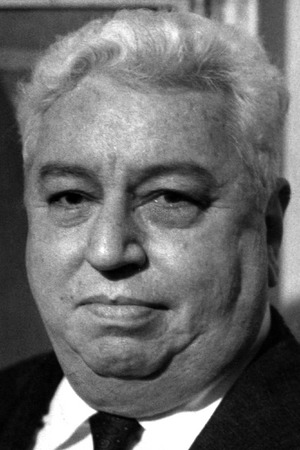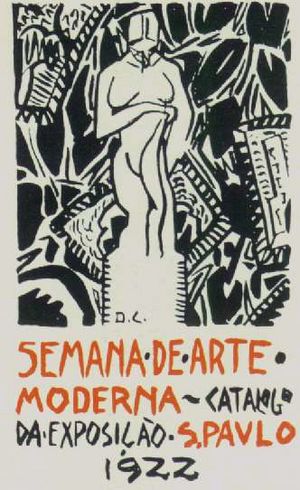Emiliano Di Cavalcanti facts for kids
Quick facts for kids
Emiliano Di Cavalcanti
|
|
|---|---|
 |
|
| Born |
emilio de Albuquerque Melo
6 September 1897 |
| Died | 26 October 1976 (aged 79) Rio de Janeiro, Brazil
|
| Nationality | Brazilian |
| Movement | Modernism |
Emiliano Augusto Cavalcanti de Albuquerque Melo (born September 6, 1897 – died October 26, 1976), known as Di Cavalcanti, was a Brazilian painter. He wanted to create a unique Brazilian art style that did not look like European art. His wife, Noêmia Mourão, was also a painter and inspired his later works.
Contents
Early Life and Art (1897-1922)
Di Cavalcanti was born in Rio de Janeiro, Brazil, in 1897. He was influenced by smart people he met at his uncle's house. His uncle was involved in the movement to end slavery. This early influence shaped his artistic career, which often had political themes.
His first drawing was published in the magazine Fon-Fon. He tried to study law in São Paulo but did not finish. In 1917, he moved to São Paulo and had his first art show. This show featured only caricatures (funny drawings of people) that showed influences from a style called Symbolism.
In 1918, Di Cavalcanti joined a group of artists and thinkers in São Paulo. This group included famous artists like Oswald de Andrade and Mário de Andrade. They helped create the important event called the Semana de Arte Moderna (Week of Modern Art) in 1922. You can see the cover page he designed for this event on the right side of this page.
This group wanted to make art in São Paulo more exciting. Their main goal was to free Brazilian art from European influences. However, the artworks Di Cavalcanti showed at the Semana de Arte Moderna still had some European styles. These included Symbolism, Expressionism, and Impressionism. This did not change until he returned from Paris in 1925.
Time in Europe (1923-1925)
Di Cavalcanti lived in Paris and Montparnasse from 1923 to 1925. During this time, he worked as a writer for the newspaper Correio da Manhã. He also took classes at the Académie Ranson in Paris. There, he met famous European modern artists like Pablo Picasso, Henri Matisse, Georges Braque, and Fernand Léger. Meeting these artists helped him want to create truly Brazilian art even more.
Back in Rio de Janeiro (1926-1936)
After returning from Europe, Di Cavalcanti started to create more Brazilian-themed art. This was something he and the Semana de Arte group had wanted since 1922. He joined the Brazilian Communist Party because he felt very patriotic after living abroad.
Di Cavalcanti's art often showed a mix of ideas. He painted Brazilian subjects, especially mulatto women (women of mixed European and African heritage). But his main artistic influences still came from European modernists, especially Pablo Picasso.
In 1929, Di Cavalcanti also began working on interior design. He created two large panels for the Teatro João Caetano (João Caetano Theatre) in Rio de Janeiro. In 1930, his art was shown in an exhibition of Brazilian art in New York City. He also became the main writer for a new magazine called Forma.
In 1932, a new art group called Sociedade Pró-Arter Moderna (SPAM) was formed. Its goal was to bring modern art to Brazil and continue the ideas of the Semana de Arte Moderna. On April 28, 1933, this group held an exhibition called Exposição de Arte Moderna. This was the first time works by Picasso, Léger, and Braque were shown in Brazil. Brazilians knew about these artists, but they had never seen their actual paintings before. The European artworks were borrowed from private collections in Brazil. This exhibition was so successful that many Brazilian artists, including Di Cavalcanti and Candido Portinari, joined the second showing.
Di Cavalcanti was put in jail twice for his political beliefs. He met his future wife, the painter Noêmia Mourão, after his first time in jail in 1932. They married the next year and traveled together until they were both jailed in 1936.
Another Trip to Europe (1937-1940)
In 1937, Di Cavalcanti and Noêmia Mourão went to Paris. They stayed there until World War II began in 1940. During this time, he won a Gold medal at an art exhibition in Paris for his murals. He created about 40 artworks, but he had to leave them behind when he and his wife fled Paris. They left just before the German Nazi invasion. They arrived back in São Paulo in 1940.
Back in Brazil (1941-1976)
After returning to Brazil, Di Cavalcanti felt even more patriotic. This showed in his art, which featured Brazilian subjects. He painted mulatto women, carnivals, Black people, quiet alleys, and tropical landscapes. These were all scenes from everyday Brazilian life.
In 1948, he gave a lecture at the Museu de Arte de São Paulo. He talked about modernism, expressing nationalism, and how he did not like abstract art. In 1951, the first Bienal (a large art exhibition held every two years) took place in São Paulo. It showed Di Cavalcanti’s works along with other artists from South America who wanted to create truly national art. The famous Mexican muralists Diego Rivera and David Siqueiros were invited by Di Cavalcanti and attended the event. The founder of the Bienal, Francisco Matarazzo Sobrinho, was so impressed that he held another exhibition in 1953. The artworks Di Cavalcanti left behind in Europe in 1940 were found in 1966 in the basement of the Brazilian Embassy in Paris.
Di Cavalcanti was good friends with Francisco Matarazzo Sobrinho. Because of this friendship, Di Cavalcanti donated 559 of his drawings to the Museu de Arte Contemporânea (Museum of Contemporary Art), also known as the MAC. The MAC now has 564 drawings by Di Cavalcanti. Only five of these were bought; the rest were donated by the artist himself.
Becoming Catholic
Di Cavalcanti used to be a member of the Brazilian Communist Party and did not believe in God. Later in his life, he became a Roman Catholic.
Art Style and Subjects
Di Cavalcanti often painted the female body in his artworks. His street scenes were usually happy and colorful. They showed everyday life in a normal way, not in a dreamy or romantic way. His paintings did not have strong political messages, unlike the works of Mexican muralists like Diego Rivera and David Siqueiros. Those artists used their art to support a revolution in Mexico. Di Cavalcanti, however, avoided clear political messages in his art. He focused on creating a pure Brazilian art style, separate from European influences.
He tried to achieve this through the Semana de Arte Moderna in 1922 and the Bienals in 1951 and 1953. He dreamed of a Brazilian art that was completely free from European styles. However, his art still showed influences from the Italian Renaissance, mural painting, and European modern artists.
List of Artworks
The artworks listed below are on display at the Museu de Arte Contemporânea (MAC) in São Paulo, Brazil.
- As cinco moças de Guaratinguetá, 1926
- This painting shows five young women. Two girls are in the front. One wears a blue dress and hat, the other a skirt and blouse with an orange hat. They carry parasols.
- Three other girls are in the background. One is looking out a window. All the girls wear hats and have similar skin tones, except for the girl in blue who has lighter skin. The simple wall behind them shows the charm of the place.
- Modern Art Week, São Paulo, 1922
- This was a very important event for modern art in Latin America. It happened in São Paulo in 1922. It showed a new vision for art that would be important for many years.
- The event lasted three days at São Paulo’s Municipal Theater. It brought different artists together and showed the public new European art styles like Expressionism and Surrealism. Before this, these styles were only seen in small ways in Brazil.
- The Modern Art Week included dance, music, theater, literature, and visual arts. It featured artists and writers who became very important in Brazilian modernism. These included Mário de Andrade, Oswald de Andrade, and Anita Malfatti.
- The event was influenced by Brazil's fast growth and modernization. It showed how Brazilian modernism was a mix of different ideas. Women artists played key roles in this event and in Brazilian modern art, especially in visual arts and dance.
- You can see the cover of the program for this event above on the right.
- Portrait of Graca Aranha, 1922
- José Pereira da Graça Aranha was born in 1868 in São Luís, Brazil. His family was wealthy, so he had a good education.
- He studied law and became a judge in Rio de Janeiro. He wrote his most important book, "Canaan," which talked about racism, prejudice, and immigration.
- He traveled to many countries as a diplomat. These trips helped him connect with the modern art movement in Brazil. He had seen European modern art firsthand.
- He helped organize the Modern Art Week in São Paulo in 1922. He was a Brazilian writer and diplomat. He also helped start the Brazilian Academy of Letters in 1897.
- Le Corbusier, 1923
- Oswald and Mario, 1933
- Maeterlinck, 1934
- Barbusse, 1935
- Duhamel, 1935
- Ungaretti, 1942
- Portrait of Augusto Schmidt, 1950
Exhibitions
- 1917 Editora do Livro, São Paulo, Brazil
- 1922 Semana de Arte Moderna, São Paulo, Brazil
- 1930 International Art Center, Roerich Center, New York
- 1932 Exposição de Arte Moderna, São Paulo, Brazil
- 1937 Art Technique Exhibition, Paris, France
- 1951 Bienal do Arte Moderna de São Paulo, São Paulo, Brazil (1st)
- 1953 Bienal do Arte Moderna de São Paulo, São Paulo, Brazil (2nd)
See also
 In Spanish: Di Cavalcanti para niños
In Spanish: Di Cavalcanti para niños
- Alfredo Volpi


